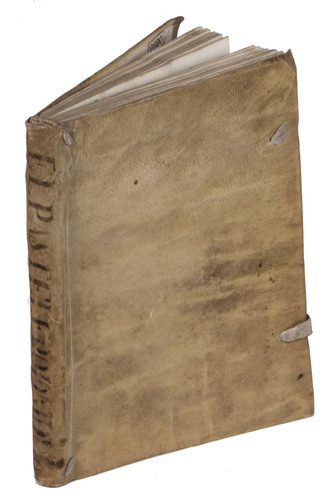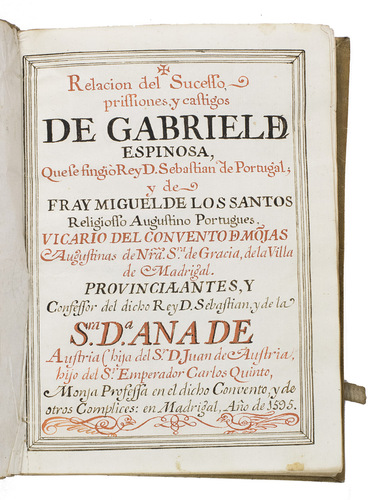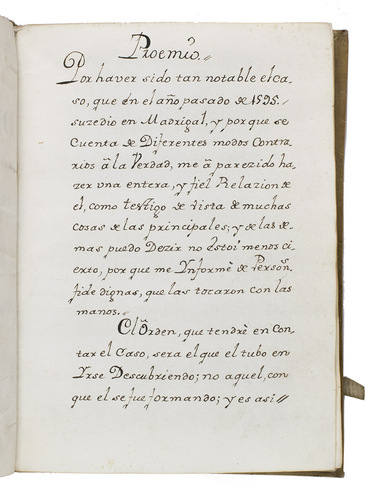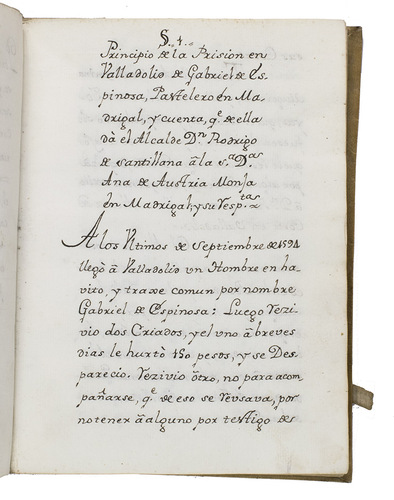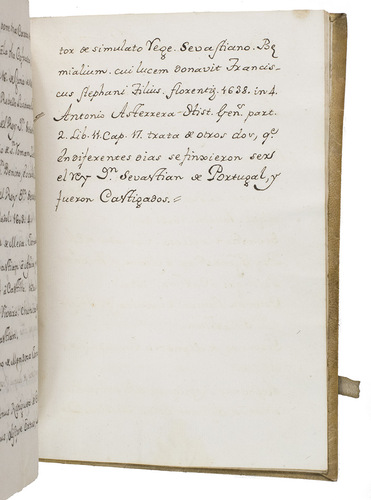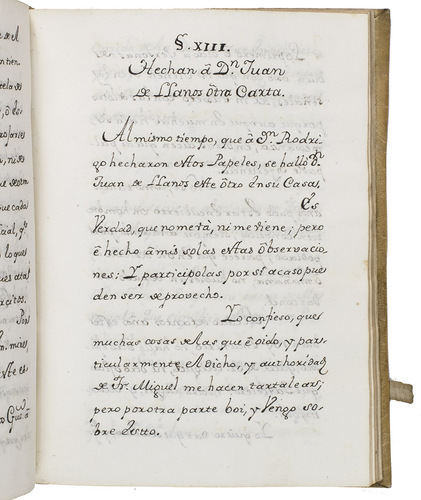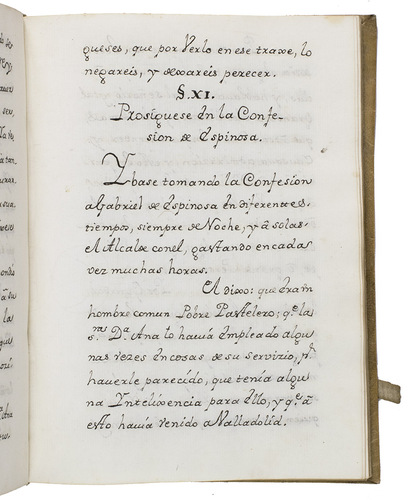[MANUSCRIPT - PORTUGAL]. MARTÍNEZ DE HERRERA.
Relacion del sucesso, prissiones, y castigos de Gabriele Espinosa, que se fingiò Rey D. Sebastian de Portugal, y de Fray Miguel de los Santos, religiosso agustino portugues, vicario del convento de mo[n]jas augustinas de Nra. Sra. de Gracia de la villa de Madrigal... confessor del dicho Rey d. Sebastian y de ... Ana de Austria (hija del Sr. D. Juan de Austria).
(In the text:) Seville, 1684. 4to. With the title written in brown and red ink within a hand-drawn frame and some bird-figures below the last line on the title-page (in red ink). The text is written in a fine 17th-century hand, in brown ink. Contemporary limp vellum, with a manuscript title on the spine and remnants of ties. [1], [1 blank], [124], [6 blank] ll.
€ 8,500
A vivid contemporary account of the arrests, investigations and fates of the notorious Baker of Madrigal, an impostor who pretended to be the late King Sebastian of Portugal (1554-78), and his co-conspirators, the friar Miguel de Ventades and Ana de Austria, the illegitimate daughter of Don John of Austria and Philip IIs niece. In 1595, "The principals and a large cast of nuns, monks, and servants were confined and questioned for nearly a year as a crew of judges tried to unravel the story, but the culprits went to their deaths leaving many questions unanswered" (R. Mackay, The Baker who Pretended to be King of Portugal, Chicago: University Press, 2012, p. xix).
"Espinosa [the Baker of Madrigal] was a man of his times: a soldier of the monarchy, a wanderer with a few marketable skills - cooking, baking, weaving - someone liminal, a charmer and a risk-taker, the future protagonist of romantic poetry and drama" (Mackay, p. 113). In "a complicated scheme of court intrigue and connections to the religious establishment, he sought to dethrone the king, Philip II, claiming his crown. The myth of Dom Sebastian elicited curiosity and interest around the Mediterranean and beyond. Its imagery of a hidden king, the geo-politics of the battle of Alcazarquivir from which the myth emerged, the crusader ideology that it embodied, and the intense circulation of the story, make this a truly Mediterranean phenomenon - one with Atlantic reach" (A. Pecar and D. Tricoire, Introduction: Reformations, Prophecy and Eschatology in Early Modern Prophecies in Transnational, National and Regional Contexts, Leiden: Brill, 2020, vol. I, p. 6).
The content of this manuscript was originally written by a contemporary who, as is explained in the prologue, had "been witness to many of the principal events in this affair" ("testigo de vista de muchas cosas de las principales") or had personally ascertained their veracity from those "reliable persons who touched them with their hands" ("y de las demas puedo Dezir no Estoi menos cierto, porque me Ynformè de Person[a]s fidedignas, que las tocaron con las manos"). As a first-hand account, it formed the basis for a printed version, the Historia de Gabriel de Espinosa Pastelero en Madrigal, que fingió ser el Rey Don Sebastian de Portugal, published in Jeréz de la Frontera in 1683 but there are significant textual differences in this manuscript because the printed version was substantially embellished for literary effect and this manuscript copy is a more raw and honest transcription of the original. Moreover, this copy includes an explanation of its inception, noting at its end that it had first been transcribed on 25 October 1647 by a Martínez de Herrera, a licenciado to the Archbishop of Seville, from a notebook belonging to Luis Camargo Pacheco (1622-1665), Bishop of Centuria (Numidia). Martínez de Herrera adds, in this entry which is dated Seville, 25 October 1684, that he had shown the manuscript to the canónigo of Seville, Diego de Castañeda, in 1678 and the latter, who had read the official documents relating to the case in the Archives of Simancas, had confirmed the veracity of the content. It is possible that Martínez de Herrera intended to publish this version as it includes an elegant title page in red and black ink and a select list of further reading and references.
The binding shows slight signs of wear, the paste-downs are creased, the blank first free flyleaf is partially detached and very slightly foxed. Internally only occasionally very slightly spotted in the margins, otherwise fine and clean. Overall in very good condition. cf. Mackay, The Baker who Pretended to be King of Portugal, Chicago: University Press, 2012; Pecar and Tricoire, Introduction: Reformations, Prophecy and Eschatology in Early Modern Prophecies in Transnational, National and Regional Contexts, Leiden: Brill, 2020.
Related Subjects:







